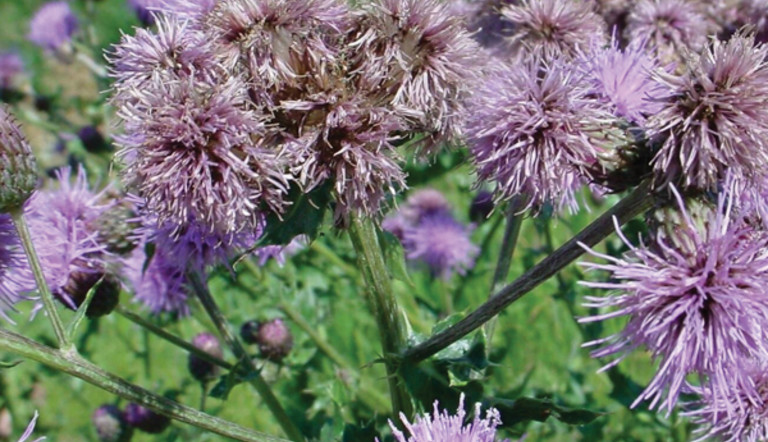
Tips for Controlling Canada thistle and Avoiding Crop Losses
Canada thistle can regenerate from tiny fragments that are able to survive in tough conditions for over three months2. Even a piece of root measuring about half a centimeter can grow into a new plant, ready to cause problems in the spring2.

The ideal time to get Canada thistle by the roots
In the fall, Canada thistle prepares for the winter by sending sugars down to its roots to stock up its reserves2. This allows for systemic herbicides like glyphosate to be translocated to the root system2. For more complete control and to avoid your risk of resistance, use a tank-mix partner with another mode of action, like PRIORITY (florasulam). Keep in mind, a systemic herbicide is only effective if:
- The plant is actively moving its reserves to the roots and
- The plant has enough healthy top growth to absorb the spray2
Spray too soon and you won’t have enough surface area for the application to provide control. Weeds cut during harvest or after tillage may need from four to six weeks to regenerate a new rosette3. Spray too late and frost could damage or kill the top growth, leaving brown or black leaves that won’t adequately absorb the herbicide3.
Time of day is also important as glyphosate becomes less effective in the late evening, early morning and before and after frost4. Whether a frost has closed your application window depends on the severity of the frost and subsequent regrowth conditions4.
Cultural practices to increase control
A traditional method was to use tillage at the flowering stage every two to four weeks to eventually drain the plants of their reserves5. However, this method is labour intensive and speeds up soil erosion5. Relying on a mechanical system also carries the risk of moving root pieces around and increasing the spread within your field3.
You can consider adding a strong competitor to Canada thistle in your crop rotation, like alfalfa or clover1. However, there’s no herbicide that controls Canada thistle without killing alfalfa and clover as well1.
Consider all your options
A weed as persistent as Canada thistle doesn’t have a quick solution. But with the right glyphosate tank-mix partner, along with cultural solutions, like early seeding and tillage, you can regain control over time.
[1] Isaacs, Julienne. “Canada thistle still on ‘least wanted’ list.” Grain News. 29 Apr 2016. Online. https://www.grainews.ca/2016/04/29/canada-thistle-still-on-least-wanted-list/
[2] Kimmel, Nicole. “Canada Thistle.” Alberta Agriculture and Forestry. 9 Jan 2015. Online. http://www1.agric.gov.ab.ca/$department/deptdocs.nsf/all/prm2585
[3] Brenzil, Clark, Holm, Rick, Hunter, Jim, and Johnston, Eric. “Canada Thistle.” Saskatchewan Ministry of Agriculture. Nov 2008. Online. http://agriculture.gov.sk.ca/adx/aspx/adxGetMedia.aspx?DocID=2250,339,185,81,1,Documents&MediaID=6497&Filename=Canada+Thistle+and+its+Control+-+Printer+Friendly.pdf
[4] Thomas, Shane. “4 Tips for Fall Weed Control After Frost.” Real Agriculture. 1 Oct 2012. Online. https://www.realagriculture.com/2012/10/4-tips-for-fall-weed-control-after-frost/
[5] Frick, Brenda. “Organic farmers share Canada thistle tales of woe.” Western Producer. 5 May 2011. Online. http://www.producer.com/2011/05/organic-farmers-share-canada-thistle-ta